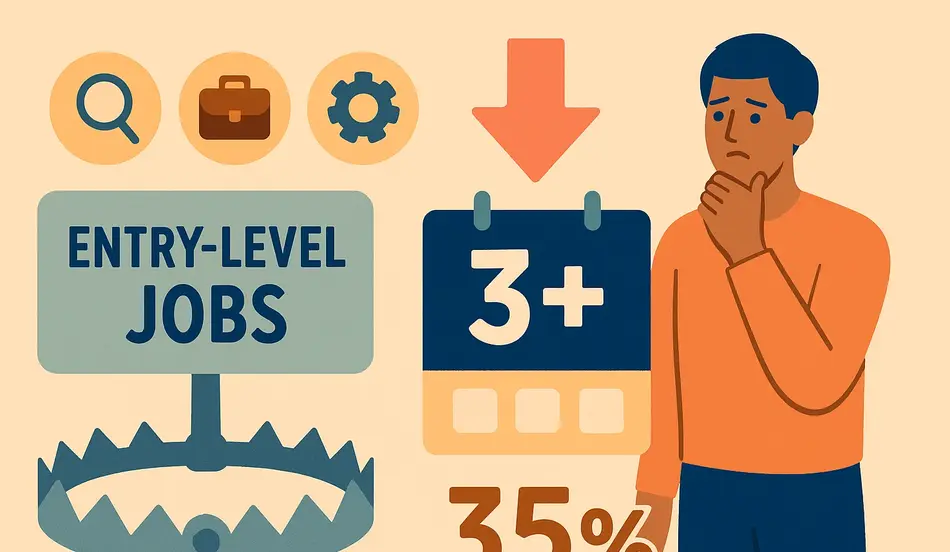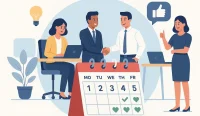The entry-level job market has become a cruel paradox that’s leaving millions of recent graduates trapped in unemployment limbo. According to recent data from Business Insider, for every 1 million listings on Indeed, the share of true entry-level roles fell 6.9% between August 2022 and August 2024. Even more alarming, roughly 35% of jobs labeled “entry-level” now require 3 or more years of experience.
This creates an impossible catch-22: how can you gain experience if every entry-level job requires experience? The very concept of entry-level positions has been fundamentally broken, leaving an entire generation of workers stranded in what feels like an endless cycle of rejection.
The Death of True Entry-Level Jobs: A Historical Perspective
How Entry-Level Jobs Were Supposed to Work
Entry-level jobs originally sprouted from a necessity to train unskilled workers in a newly growing economy. At the dawn of the industrial revolution, people were moving from farms to cities and from informal labor to structured clock-in, clock-out work. Businesses as we know them today were just as new as the jobs they created, so they didn’t have time to wait around for the perfect candidate.
The Original Entry-Level Promise
Companies hired people with no experience and taught them on the job. Basically, all you needed during the hiring process was a strong determination to learn and some confidence. That was the entire point of an entry-level job—though back then they were simply referred to as “jobs.”
For the next couple hundred years, the hiring process largely remained the same: search for a job in the help-wanted section of the newspaper, go to a job fair, or get lucky enough to know someone at a company who would hire you.
The Five Major Shifts That Killed Entry-Level Jobs
Several massive shifts occurred starting in the 1980s that fundamentally changed how companies approach hiring, making it nearly impossible to get a job without prior experience.
Shift 1: Shareholder Value Over Worker Development
The Profit Obsession That Changed Everything
America’s obsession with profits and productivity kicked into high gear in the late 1970s and early 1980s, fueled by a cultural shift toward shareholder primacy. As Harvard Business Review reporter William Lazonick pointed out, from the end of World War II until the late 1970s, a “retain and reinvest” approach provided workers with higher incomes and greater job security.
This pattern began to break down in the late 1970s, giving way to a “downsize and distribute” regime of reducing costs and then distributing the freed-up cash to financial interests, particularly shareholders.
The Training Cost Problem
When you treat labor as a cost to minimize rather than an asset to grow, training new workers becomes an unnecessary expense. Why hire someone fresh out of college and invest in them when you can demand a ready-made employee and offload the cost of development onto the worker?
The irony is that this line of thinking doesn’t even help companies prosper in the long run. A 2016 study by consulting services provider Accenture found that for every dollar a company spent on reimbursing an employee’s college tuition, the company generated $129 in cost savings for retention and talent management.
Shift 2: The Internet Job Posting Revolution
How Online Platforms Changed Everything
When platforms like Indeed and LinkedIn became popular, “apply-maxing” became the new meta. Suddenly, applicants could filter for job type, experience, company, and reviews, instantly upload their resume, and hit apply. As a result, companies often receive as many as a thousand applications per day.
The Numbers Game Problem
This volume completely changed how hiring works. Before online platforms, companies had to actually interact with people—host job fairs, interview candidates in person, and scan printed resumes. Now, hiring is more of a numbers and filtering game.
What’s one of the easiest ways to filter through thousands of applications? You slap on a three-to-five years of experience requirement, even if the job doesn’t actually need it.
The ATS Problem: Digital Bouncers
Another way companies simplify this hiring process is through Applicant Tracking Systems (ATS). These systems are basically digital bouncers—you upload your resume thinking a human will see it, but in reality, a robot scans it first.
If your resume doesn’t match a certain format, lacks specific keywords, or just doesn’t look the way the algorithm expects, it gets rejected before it ever lands in front of a hiring manager.
The Experience Filter Trap
If you’re a company getting hundreds or thousands of applications for every role, you need filters. So what do you do? You set a minimum experience requirement—not because it’s necessary, but because it helps your system shrink the pool.
According to a joint Harvard Business School-Accenture study, a significant majority (88%) of employers believed that qualified, high-skills candidates were vetted out of the process because they did not match the exact criteria established by the job description. That number rose to 94% in the case of middle-skills workers.
Shift 3: The Pandemic’s Lasting Impact
How COVID-19 Accelerated the Problem
In the early weeks of COVID, about 27 million workers lost their jobs, with bottom-quintile, lower-wage workers hit six times harder than those at the top. New grads and less experienced folks were the first to get wiped out.
When companies started restaffing, they didn’t bounce back widely—they looked for experience they already had. A 2021 survey from NACE found that hiring for interns and co-op students dropped significantly, with co-ops taking a bigger hit as many roles were paused, cancelled, or moved online.
The Remote Work Preference
Employers with the benefit of remote work may also utilize it to hire experienced workers with entry-level pay. As one managing director put it, “Maybe you don’t have to take a shot on a fresh college grad or someone that has one year of experience because someone has 5 years experience and will be willing to take that same amount of pay because they can sit in their own home.”
The Internship Crisis
Internships are meant to be the key to getting past the new entry-level experience barrier. Most of the time, when companies say they’re looking for an entry-level employee with 3-5 years of experience, they don’t just mean that you’ve been working for pay—they want to know that you’ve been doing and using the relevant skills in a professional setting for 3-5 years.
But because of the pandemic, not only did hiring for interns drop, but also the number of internship openings dropped significantly—a 52% decrease according to Glassdoor. While they did see a significant jump following the years after the pandemic, the latest data shows that internship postings have dipped below 2019 levels.
Shift 4: AI and Automation Threat
The White-Collar Automation Problem
We’ve been hearing about robots taking jobs for decades, but what’s really changed is what AI is actually capable of now. We’re no longer just talking about machines replacing factory workers—we’re talking about entry-level white-collar work like customer service, scheduling, data entry, content generation, and even writing resumes being handed off to software.
A Goldman Sachs analysis estimated that up to 300 million full-time jobs globally, including admin, legal, and basic tech roles, are exposed to some degree of AI automation. That means many of the gigs people formerly used to get their foot in the door are being taken over by software.
The Tech Layoff Connection
The AI automation threat has felt especially pertinent recently, with massive tech layoffs constantly happening because any entry-level software development roles can just easily be done by AI now.
Shift 5: Obsolete College Degrees
The Degree Inflation Implosion
It should be obvious by now, but the fact is college does not offer the same sort of labor benefits as it did 15 years ago. According to research by the San Francisco Federal Reserve, 2010 marked a turning point when the lifetime earnings gap between college grads and high school graduates stopped widening, even slightly declining in some cases.
In Strata’s recent “Talent Disrupted” report, only about half of bachelor’s grads land a college-level job within a year after graduation, and a whopping 52% remain underemployed.
The Skills-Based Hiring Revolution
The Burning Glass Institute’s emerging degree reset showed that between 2017 and 2019, 46% of middle-skill and 31% of high-skill jobs dropped their college degree requirement. Major employers like IBM, Google, and Delta have officially removed degree requirements for certain roles, admitting that specific skills and real-world abilities matter more than the piece of paper.
The Current Crisis: Record Unemployment Gap
The Largest Gap in 40 Years
Because of all these factors and the current internship opportunity problem, we are experiencing the largest gap between the overall unemployment rate and the unemployment rate for people who recently graduated from college in the last 40 years.
If you’re wondering why so many young people feel stuck, it’s not laziness—it’s not entitlement. It’s that the very pathways that were supposed to help them get started were quietly taken away from them and never fully brought back.
Solutions: Navigating the Broken System
Systemic Changes Already Happening
The good news is that a growing number of states like Maryland, Pennsylvania, Utah, Alaska, and New Jersey have removed four-year degree requirements for thousands of public sector jobs. This is on top of what major employers are already doing by removing college degree requirements from many of their roles.
Personal Strategies for Success
1. Build a Portfolio (Even Without Pay)
Having proof that you understand how to solve problems in the real world through a portfolio website is pretty much necessary at this point. You’re not going to get paid for all the work you do—you’ll be doing projects that are difficult for no pay on your own time—but it’s clear that you’ve got to show these companies that you know what you’re doing by pursuing something in your free time that’s related to the job you want.
2. Alternative Credentials
A 2022 SHRM learning study found that 88% of executives and 76% of supervisors believe these credentials are as good or better than traditional degrees for some roles. Programs like Google Career Certificates, Coursera, and Skillstorm are gaining more credibility, especially in IT, project management, and data analytics.
3. Strategic Resume Optimization
Some people need to optimize their resumes strategically. If you want more opportunities and you believe you’re confident enough to pass interviews and succeed in a role right out of college or just with no experience, set up your resume so that these systems will approve them and go from there.
Hiring? Post Jobs for Free with WhatJobs
Are you an employer looking to hire in this evolving landscape? Post your job openings for free and connect with talented professionals who are thriving in the skills-based economy. Whether you’re seeking adaptable team members or experienced specialists, WhatJobs helps you find candidates with the practical skills and growth mindset your business needs in 2025.
Post a Job Now →Navigating this broken hiring system requires expert guidance. Our career advisors can help you:
- Identify skills-based hiring opportunities
- Build a compelling portfolio that showcases your abilities
- Navigate ATS systems and optimize your resume
- Find alternative pathways to gain relevant experience
- Develop strategies for companies that value potential over experience
Frequently Asked Questions
Q: Why do entry-level jobs now require 3+ years of experience?
A: The entry-level job experience paradox stems from companies prioritizing shareholder value over worker development, the rise of online job platforms that receive thousands of applications, and the use of ATS systems that filter candidates based on experience requirements rather than actual job needs.
Q: How can I gain experience when entry-level jobs require experience?
A: Focus on building a portfolio of relevant projects, pursue alternative credentials like Google Career Certificates, seek out apprenticeship programs, and consider freelance or contract work to demonstrate your skills and abilities to potential employers.
Q: What industries are most affected by the entry-level experience paradox?
A: Technology, marketing, finance, and administrative roles are particularly affected, as these industries have seen significant automation and increased competition for positions, leading to higher experience requirements for what should be entry-level roles.
Q: How has AI automation impacted entry-level job opportunities?
A: AI automation has eliminated many traditional entry-level white-collar positions like data entry, basic customer service, and content generation, making it even harder for new graduates to find their first professional opportunities.
Q: What systemic changes are needed to fix the entry-level job market?
A: Companies need to return to investing in employee development, states should continue removing degree requirements for public sector jobs, and the hiring process should prioritize skills and potential over rigid experience requirements that create impossible barriers for new workers.
The entry-level job experience paradox represents a fundamental failure of the modern hiring system. While individual strategies can help navigate this broken landscape, true solutions require both personal adaptation and systemic change. The good news is that signs of progress are emerging, with more companies and states recognizing the value of skills-based hiring over rigid experience requirements.




